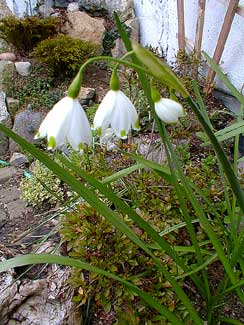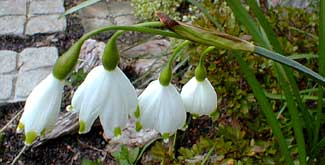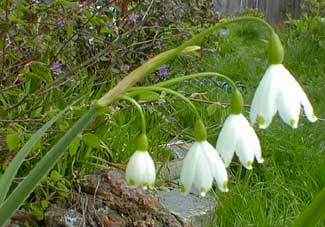
Summer Snowflake, or
Loddon Lily
"The earth laughs in flowers."
-e. e. cummings
(1904-1962)
(1904-1962)
Underneath the Vine Maple is a patch of Summer Snowflake or Snowflake Lily (Leucojum aestivum). These poke their thick green blades out of the ground in January & become taller & taller through February & March.
"Summer Snowflake" is a poor choice of popular name & it is frequently shortened to "Snowflake" because it actually blooms primarily in April & May (rarely persisting into June), & for leaves has a solid late winter presence. On Puget Sound, like so many bulbs, it is long gone by summer.
This perennial of the amaryllis family has grassy foliage, an upright scape (or flower stalk) to two feet or a bit more. Bulbs should be planted in autumn. In April, after the grass had already been developing for two months or so, the sweeping scapes dangled forth lightly scented white blooms which look exactly like the flowers on snowdrops.
 By April the early-blooming Galanthus nivalis or Lesser Snowdrop has finished blooming though its leaves are still fresh-looking. Slightly taller than the Lesser Snowdrop is Leucojum vernum or Spring Snowflake which looks like a diminuative Snowflake Lily, but blooms earlier.
By April the early-blooming Galanthus nivalis or Lesser Snowdrop has finished blooming though its leaves are still fresh-looking. Slightly taller than the Lesser Snowdrop is Leucojum vernum or Spring Snowflake which looks like a diminuative Snowflake Lily, but blooms earlier.When the last of the Lesser Snowdrops & Spring Snowflake do finally give out, there'll still be the vastly taller Snowflake Lily showing the same blossoms for some while, certainly into May. The bell-like flowers even sport the green dot on the fringe of each petal just like the Snowdrop.
 Snowflake lilies are native of the Mediterranean area, but don't seem to mind a more temperate climate at all. They naturalize with great ease & return year after year. They take no special care on Puget Sound, but in colder zones might ask for a winter mulch to protect the bulbs. They are perhaps a little too sturdy for some zones, as in many areas of the east, as far north as New England, they have escaped to the wild.
Snowflake lilies are native of the Mediterranean area, but don't seem to mind a more temperate climate at all. They naturalize with great ease & return year after year. They take no special care on Puget Sound, but in colder zones might ask for a winter mulch to protect the bulbs. They are perhaps a little too sturdy for some zones, as in many areas of the east, as far north as New England, they have escaped to the wild.They can be dug up for division every three or four years, but as ours are imbedded among the roots of the vine maple, they'll probably never be lifted ever. Time will tell if they eventually tire & decline for lack of division, or if they'll be there always.
They want full sun to light shade in the north, partial sun or partial shade in the south. When positioning ours the thought was that they would bloom before the vine maple releafed, & therefore get plenty of sun, but their blooms were not quite as early as that, & they continue to bloom rather longer than expected. Still, the leaves fill out nicely while the sun can still get through the vine maple's branches, & the Snowflakes seem to be doing fine with almost as much light as would be ideal.
They need to be watered regularly during spring growth & throughout their flowering period, when it tolerates very soggy soils but will do very badly if the soil gets dry. When it becomes dormant in summer it then needs no watering until the next spring. It can be planted among daffodils which want very similar conditions.
L. aestuvum (as also L. vernum, & L. autumnale) have been in English gardens since the Elizabethan age. Summer Snowflake was in those days known as Early Summer Fooles, or by a name adapted from the Dutch, Summer Sottekins. In parts of rural England where it has naturalized it is still known as the Wild Loddon Lily.